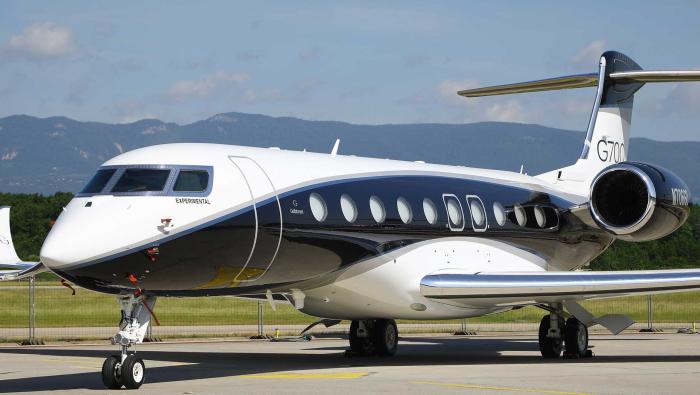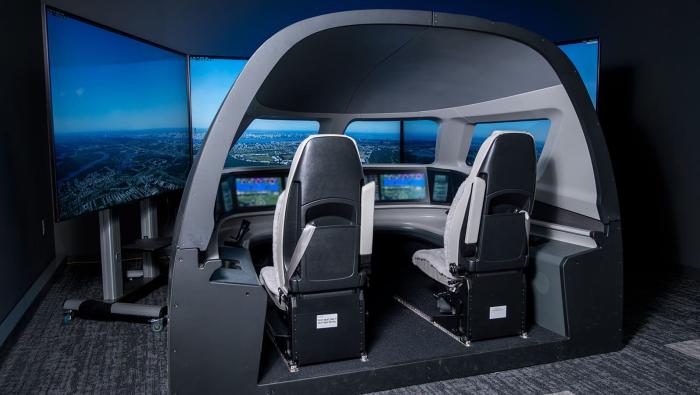|
Revenues at General Dynamics’ aerospace division, which includes Gulfstream Aerospace and Jet Aviation, climbed 4.1% year over year to $3.062 billion in the second quarter, while profits soared 26.3%, to $403 million. That was thanks to higher deliveries at Gulfstream—38 aircraft (32 large-cabin jets and six super-midsize G280s) versus 37 (31 large-cabins and six G280s) in the same period last year—and a more favorable mix in the three-month period, with 15 G700s handed over. In the first six months, Gulfstream shipped 74 jets (62 large-cabins, 12 G280s), compared with 61 (59 large-cabins, nine G280s) in the first half of 2024. General Dynamics chairman and CEO Phebe Novakovic slightly raised Gulfstream forecast deliveries for this year to 150 to 155 aircraft, with G800 shipments expected to start in the current quarter. She added that the first 20 G800s will be handed over to G650 customers. Novakovic said Gulfstream’s current production capacity is 200 aircraft a year. Meanwhile, she noted that demand for Gulfstreams remains strong, with sales spread across the product line and also around the world, with North America, Europe, and the Middle East specifically mentioned. Book-to-bill was 1.3:1 during the quarter, prompting aerospace backlog to rise to $19.9 billion, up nearly $1 billion from late March and the highest since 2022. |
|
|
Available inventory of used business jets has inched downward this month year over year (YOY) to 1,189, but jumped by 11% for those less than seven years out of production, according to a recent report from analyst Jefferies. For all business jets, light jets led the YOY decline, down 5%, followed by heavy jets, dipping 1%. These offset a 2% increase in available used midsize jets, Jefferies reported, citing its analysis as well as Amstat data. Business jets for sale were down from 1,207 a year ago. Available aircraft represented 4.7% of the overall fleet, still near historic lows seen in recent years. Meanwhile, pricing for younger jet models dropped by 6% as inventory grew to 3.6% of the fleet, up from 3.4% a year ago. However, available inventory for younger models was unchanged from June. Available Bombardier jets were down by 3% YOY to 62 units, representing 3.4% of the fleet, while preowned Falcon inventory was flat YOY at 25 units. Gulfstream inventory climbed 11% YOY to 61 units, driven by an additional nine G650s on the market as more G700s enter service. Eighty-one Cessna Citations were up for sale, a 21% YOY increase, with seven more M2s and four more Sovereigns on the market. The number of Embraer business jets for sale was up 26% to 39 units. |
|
|
This week at EAA Airventure, aircraft modification specialist Blackhawk Group announced it has submitted a request to the FAA for a supplemental type certificate (STC) on its XP66D engine upgrade for Daher TBM 700-series turboprop singles. Replacing the original stock 700-shp Pratt & Whitney Canada PT6A-64 engine with the 850-shp PT6A-66D brings the TBM 700 performance on par with that of the upgraded TBM 850. Blackhawk’s testing data reveals that the modification slashes time-to-climb to FL310 by six minutes and increases maximum cruise by an average of 25 knots to more than 300 knots. Additionally, the more powerful turboprop engine offers lower operating costs and enhanced safety margins with its increased power, according to Blackhawk. “The new XP66D engine upgrade exemplifies Blackhawk’s commitment to pushing the boundaries of innovation in the aviation industry,” said Edwin Black, president of Blackhawk’s proprietary upgrades division. “This upgrade combines our extensive experience in STC development with the deep TBM platform knowledge of [our] Avex performance center, delivering a transformative performance solution to TBM 700 owners.” Its certification testbed—a 2004 TBM 700C2—is on display this week at EAA AirVenture. The airplane, which is available for purchase, has been fully refurbished and features an upgraded cockpit and cabin, in addition to the engine upgrade. |
|
|
Embraer finished off the second quarter with a record backlog. Among the major business jet manufacturers, the Brazilian airframer is unique in that it plays in both the commercial and private aviation markets. On the commercial side, it reported an eight-year-record backlog of $13.1 billion for its E-Jet family. Meanwhile, its executive aviation division—with the highest book-to-bill ratio in the industry—posted a backlog of $7.4 billion at the end of the quarter, representing a 62% year-over-year (YOY) increase but a slight decrease from the first quarter. In the second quarter, Embraer delivered 38 business jets, a 41% increase over the 27 handed over during the same period a year ago, and 8% higher than the OEM’s five-year average for the quarter. Embraer's services and support unit increased its backlog by 55% YOY, reaching $4.9 billion. A highlight in the quarter was the announcement that it will offer the Gogo Galileo HDX connectivity solution on the Phenom 300 via a supplemental type certificate developed in partnership with Gogo. FAA approval for this is expected by October. Meanwhile, Embraer noted that it is the main exporter of high-value-added goods in Brazil. On this note, the company will discuss the threat of possible U.S. tariffs during its second-quarter results call on August 5. |
|
|
Sponsor Content: RTX Semi-autonomous software systems can help with manual tasks and cognitive calculations, freeing pilots to focus on critical thinking and decision-making. Collins Aerospace, an RTX business, has been developing and testing those systems. |
|
|
The Air Charter Association (ACA) has confirmed internship places for 15 young people interested in pursuing careers in the industry. Next month, the group—aged between 18 and 25 years old—will participate in a week of training at London Biggin Hill Airport, the industry group announced today. Six women and nine men make up the cohort, including a mix of high school graduates, university students, and graduates. They have expressed interest in focusing on tasks including brokering charter flights, operations management, and aircraft maintenance. During the week in mid-August, the interns will engage with industry experts from among ACA’s members. They will visit businesses at Biggin Hill Airport, including FBOs and aircraft operators. Each intern will also undertake a work placement with one of the group’s 440 member companies to gain first-hand experience of working in the industry and conduct an aviation-focused research project. In November, the interns will attend the ACA’s Air Charter Excellence Awards event, at which the best project will be announced. “The ultimate goal of the internship program is to support talented young people into employment within the air charter sector, and so it is fantastic to see the value of the program in delivering opportunities,” said ACA CEO Glenn Hogben. “The internship class of 2025 has a great mix of aspiring aviation professionals.” |
|
|
President Donald Trump’s nomination for the role of ambassador and U.S. representative to the International Civil Aviation Organization is rankling the Air Line Pilots Association (ALPA), which has been at loggerheads with the nominee, Jeffrey Anderson, over the airline pilot mandatory retirement age. On Thursday, the White House announced the nomination of Anderson to the role that has been vacant since C.B. “Sully” Sullenberger, the famed pilot who successfully landed an Airbus A320 on New York’s Hudson River in 2009, abruptly resigned in June 2022, just six months into the post. Anderson—who had served as a Delta Air Lines pilot for 25 years and as Delta’s national representative with ALPA, as well as on the union’s PAC board—has also founded and served as policy director with Enclave Policy Partners to provide independent policy analysis. However, he has campaigned to raise the airline pilot retirement age from 65 to 67, writing an opinion piece in 2024 entitled “How the Pilots Union Campaign Against Its Own Members Could Mean Heavy Turbulence for Organized Labor and Their Champions in Washington.” Shortly after Trump's announcement, ALPA voiced strong opposition to Anderson’s selection, issuing a statement that Anderson “is unqualified” to fulfill the mission of maintaining the U.S.’s global leadership in aviation safety. |
|
|
Yesterday at EAA AirVenture in Oshkosh, Wisconsin, Transportation Secretary Sean Duffy and FAA Deputy Administrator Chris Rocheleau announced that the FAA has published the final version of the Modernization of Special Airworthiness Certification (Mosaic) rule. This rule amends the light-sport aircraft rules that came into effect in 2004 but had significant limitations, such as a maximum aircraft weight of 1,320 pounds and no explicit permission for electric-powered aircraft. “I can’t think of a better place than at the largest general aviation airshow in the U.S. to announce that we’re unleashing American ingenuity,” Duffy said. “This new rule will promote better designs, safer materials, and upgraded technology in the recreational aviation sector. Our recreational pilots and plane manufacturers have correctly noted outdated regulations were inhibiting innovation and safety. No more. Let’s bring this industry into a new age.” Under the Mosaic rule, a sport pilot will be able to operate aircraft with up to four seats but limited to carrying two occupants. New privileges under the rule include operating helicopters, flying at night, aircraft with retractable landing gear, and aircraft with constant-speed propellers. There are no limits on weight nor on powerplants, which could have implications for advanced air mobility aircraft. The rule also amends limits on cruise speed and maximum stall speed, the latter of which is 61 knots for a powered airplane. |
|
|
|
|
|
|
AINalerts News Tips/Feedback: News tips may be sent anonymously, but feedback must include name and contact info (we will withhold name on request). We reserve the right to edit correspondence for length, clarity, and grammar. Send feedback or news tips to AINalerts editor Chad Trautvetter. |
|
AINalerts is a publication of AIN Media Group, 214 Franklin Avenue, Midland Park, New Jersey. Copyright 2025. All rights reserved. Reproduction in whole or in part without permission is strictly prohibited. |















